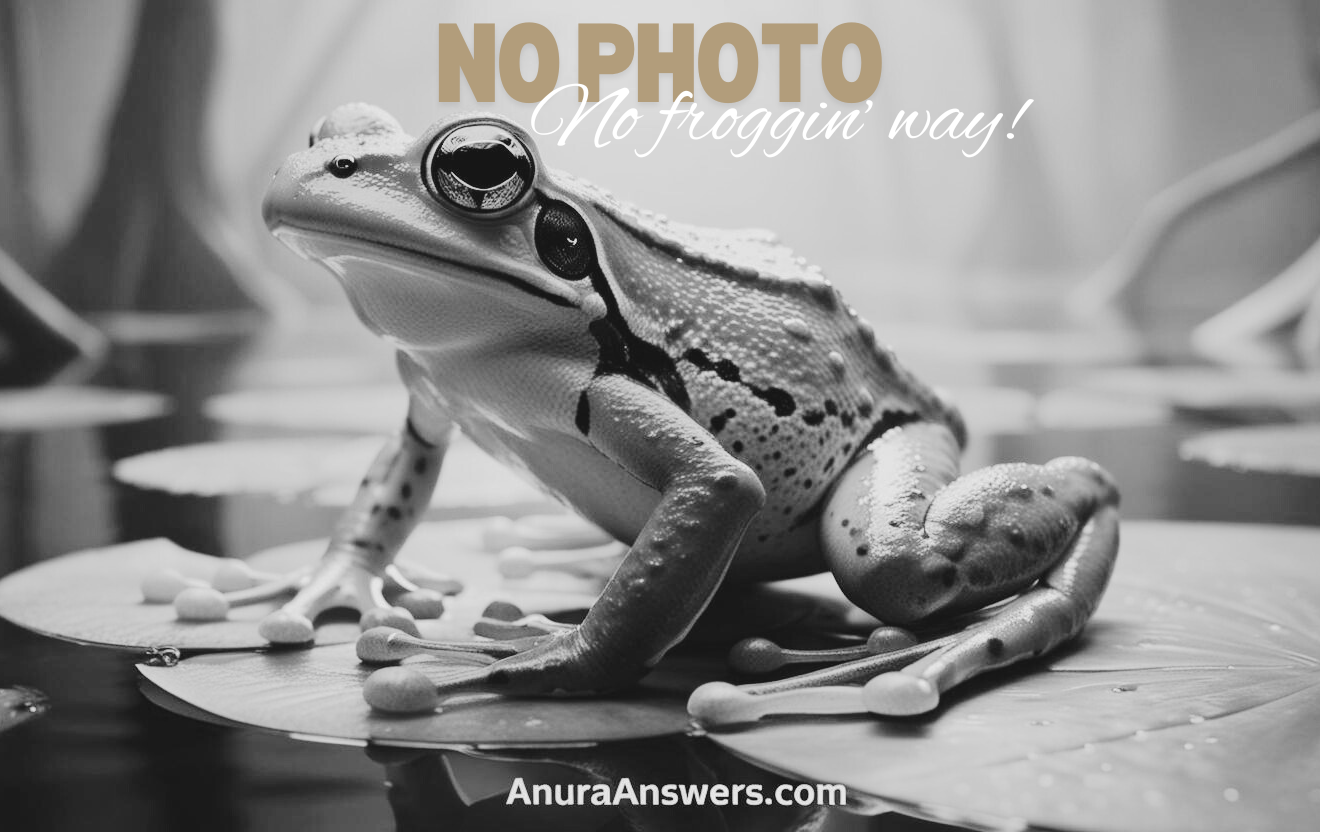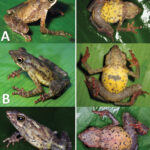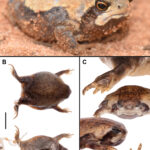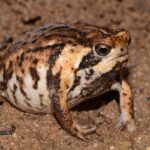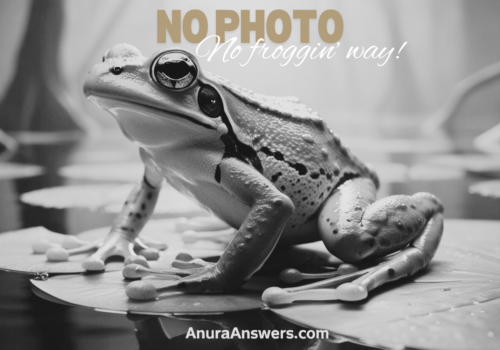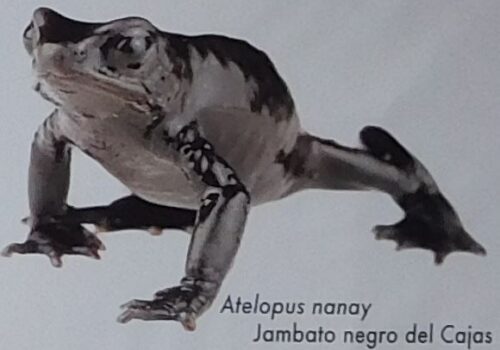- Unveiling the Mysteries of the Elusive Night Frog: A Deep Dive into <em>Atelopus nocturnus</em>
- Taxonomy and Classification
- Natural Habitat: Tales from the Tropical Night
- Physical Characteristics: Nature’s Hauntingly Elegant Design
- Behavior and Life Cycle: Secrets of the Nocturnal Frog
- Ecological Role: Guardians of the Forest Stream Ecosystem
- Threats and Conservation Status: Facing Dawn’s Uncertain Future
- Cultural and Scientific Significance: An Enigmatic Frog’s Gift to Humanity
- Conclusion: A Call to Preserve the Twilight Dancer
Unveiling the Mysteries of the Elusive Night Frog: A Deep Dive into Atelopus nocturnus#
Hidden beneath shadows of towering tropical trees and emerging only beneath night’s gentle veil, Atelopus nocturnus, often called the Nocturnal Harlequin Frog, is a creature that dances between mystery and majesty. Within dense rainforests and cascading mountain streams, its silhouette moves gracefully through darkness, a symbol of nature’s quiet resilience and the fragility of delicate ecosystems.
To glimpse an Atelopus nocturnus is to witness nature’s mastery of subtlety—a creature shaped through millennia of evolution, yet now confronting perilous challenges. Despite its small stature and secretive nightly wanderings, this frog species embodies a larger story: one of biodiversity, survival, and the interconnected threads of life on Earth.
Taxonomy and Classification#
The taxonomy of Atelopus nocturnus situates it within a unique and fascinating lineage of amphibians. It belongs to the Bufonidae family, more commonly known as the true toads, within the genus Atelopus. Often referred to collectively as harlequin frogs or stubfoot toads, the genus Atelopus comprises vibrant, slender-bodied amphibians known for their distinctive coloration and captivating habits.
Atelopus nocturnus was formally described relatively recently, highlighting how even today, the rainforests of South America continue to present scientists and conservationists with joyous discoveries. Closely related species, such as Atelopus varius and Atelopus zeteki, share similar morphological features yet permit A. nocturnus its own special ecological niche—dominated by its preference for nocturnal activity.
Natural Habitat: Tales from the Tropical Night#
Venturing into the lush heartlands of southern Ecuador, and regions of northern Peru, one enters the verdant kingdom that Atelopus nocturnus calls home. Cloud forests and moist, shaded valleys defined by pristine flowing streams set the stage for the nocturnal dance of this elusive amphibian. Thriving between elevations of 600 and 1,500 meters, the moisture-laden air and frequent misty rains conjure an ideal sanctuary.
Here, the line between earthly paradise and biological imperative blurs, as nightly rituals unfold beneath moonlit canopies. These frogs are uniquely adapted to such environments, aligning their behaviors and biology with ambient humidity, cool temperatures, and the clear, slow-water currents of sheltered forest streams.
The habitats preferred by Atelopus nocturnus remain shrouded in twilight, thus avoiding the heat of midday sunlight. Their night-dependent lifestyle requires a dynamic, delicate equilibrium, further indicating the critical role pristine ecosystems play in their continued survival.
Physical Characteristics: Nature’s Hauntingly Elegant Design#
In quiet admiration, one can marvel at the arresting elegance of Atelopus nocturnus. With a body length hovering around two to four centimeters, this small amphibian seems almost ephemeral—as if sculpted directly from shadow and moonbeam. Their thin yet elongated limbs lend them grace; adept climbers and agile jumpers, these diminutive frogs move with breathtaking fluidity through tangled forest understories.
The coloration and patterns of Atelopus nocturnus are true to the ‘harlequin’ nickname of its genus. Its velvety skin, painted in dark hues varying from deep charcoal to blackish-brown, facilitates perfect camouflage among wet leaves and rock formations. Gentle strokes of golden or cream-colored hues along the legs and sides accentuate their cryptic design, betraying their presence only briefly under moonlight before they vanish once more into darkness.
This sophisticated pigmentation not only confers concealment—it also serves as a silent signal of natural caution. Many Atelopus frogs possess skin toxins as a defense mechanism against predation. While precise toxic properties of Atelopus nocturnus continue to intrigue researchers, the family Bufonidae is famously known to harbor protective toxins that ward off predators, making them formidable small creatures within their microhabitats.
Behavior and Life Cycle: Secrets of the Nocturnal Frog#
Nighttime Foraging and Predation#
As the sun dips below the horizon, Atelopus nocturnus stirs from daytime shelters hidden among leaf litter and damp rocky crevices. With remarkable quietness and elegant movements, they begin to track insects and small invertebrates through their nightly haunts. Crickets, small beetles, ants, and flying insects lost among the foliage become their primary prey, effortlessly ensnared by quick, precise strikes from protruding tongues.
Mating Rituals Beneath Moonlight#
With rainy season arrivals, a subtle chorus echoes softly along moonlit streams. Male Atelopus nocturnus, carefully perched upon rocks or foliage beside calmly flowing pools, produce subdued calls—gentle, rhythmic chirps that reverberate subtly through cool forest air. Females, guided by these delicate serenades, gently approach observant males in a nocturnal ballet preceding mating. Together, they lay their eggs beneath rocks or among secluded riverbeds, shielded from predators and turbulent currents.
Tadpoles emerge weeks later, inconspicuous and well-adapted to calm water environments. These young creatures adopt cryptic behaviors and coloration to evade predators during development. Once fully metamorphosed, new generations disperse, repeating the intricate journey that defines the continued lineage of their kind.
Ecological Role: Guardians of the Forest Stream Ecosystem#
Although modest in size, the influence of Atelopus nocturnus extends far beyond their diminutive frames. Their importance is immense in shaping healthy ecosystems. As insect predators, they are integral in controlling populations of pests and other arthropods, thus balancing delicate food webs. Concurrently, they serve as prey for snakes, birds, and larger amphibians and reptiles—a pivotal link firmly embedded within rainforest biodiversity.
One vital aspect of their ecological significance emerges from their status as bioindicators. Harlequin frogs, such as Atelopus nocturnus, are widely considered exceptional indicators of habitat health and cleanliness; their sensitivity to environmental changes, particularly habitats disturbed by pollution, shifts in humidity levels, or temperature fluctuations, renders them ecological canaries, swift messengers signaling ecosystem-wide alterations.
Threats and Conservation Status: Facing Dawn’s Uncertain Future#
Sadly, these captivating creatures stand at the precarious crossroads of survival and vulnerability. Habitat destruction poses a grave concern; rainforest clearance for agriculture, logging, road-building operations, and expanding human infrastructures imperil their habitats with alarming frequency.
Another significant threat arises from the sinister chytrid fungus (Batrachochytrium dendrobatidis), which has severely impacted amphibian populations worldwide. Highly sensitive to this pathogen, Atelopus nocturnus faces a potentially devastating risk, a threat exacerbated by climate-induced habitat alterations that encourage fungal growth.
The International Union for Conservation of Nature (IUCN) classifies this species as critically endangered, sternly reminding us of its urgent conservation needs. Hope remains alive in the concerted conservation efforts ignited globally; captive breeding programs, habitat protection initiatives, pathogen mitigation strategies, and education campaigns highlight our collective moral obligation to safeguard these wondrous amphibians.
Cultural and Scientific Significance: An Enigmatic Frog’s Gift to Humanity#
Beyond their ecological roles, harlequin frogs like Atelopus nocturnus have threaded themselves into indigenous cultures as symbols of natural harmony, rain, and fertility. Their presence and survival mirror a region’s overall environmental health, reinforcing culturally-embedded respect within local traditions.
Scientifically, understanding their biology—particularly their unique skin compounds—continues to inspire novel medical research targeting antimicrobials, antivirals, pain medications, and other biological innovations. Each discovery underscores the invaluable potential these amphibians offer humanity, serving as irreplaceable fountains of knowledge and exploration.
Conclusion: A Call to Preserve the Twilight Dancer#
The story of Atelopus nocturnus reverberates profoundly, encapsulating the vibrant beauty, intricate vulnerability, and essential interconnectedness of wildlife. As guardians of biodiversity, we bear an urgent responsibility to hear nature’s subtle whispers and champion conservation efforts for these dazzling frogs.
Let our shared mission be the preservation of forests, streams, and moonlit amphibian serenades, ensuring future generations glimpse the haunting elegance of the mysterious Nocturnal Harlequin Frog for decades to come.
